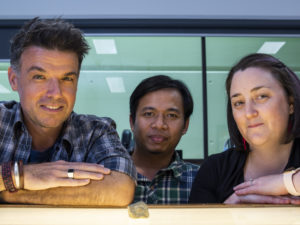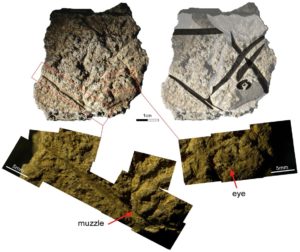An international team of researchers led by Griffith University has uncovered the first known examples of ‘portable art’ from the Pleistocene period, or Ice Age, in Southeast Asia, which were small engraved rocks believed to have acted as a ‘social glue’ that bonded early human societies.
Two flat, palm-sized rock ‘plaquettes’, excavated from a limestone cave on the Indonesian island of Sulawesi, were discovered by the archaeological team in 2017 and 2018 — one engraved with a sun or eye-like image and the other with the head and upper body of an anoa, a wild dwarf buffalo found only on this island.

Professor Adam Brumm, PhD candidate Adhi Agus Octaviana and Dr Michelle Langley.
The paper ‘Portable Art from Pleistocene Sulawesi’ has been published in the prestigious journal Nature: Human Behaviour, in which the team dated these small stones that had been intentionally engraved with figurative art as being 26,000 to 14,000 years old.
Archaeologists Dr Michelle Langley and Professor Adam Brumm from Griffith’s Environmental Futures Research Institute worked alongside researchers from several Indonesian institutions, including the Pusat Penelitian Arkeologi Nasional (ARKENAS), Balai Akeologi Sulawesi Selatan, Hasanuddin University, and Balai Pelestarian Cagar Budaya in Makassar.
Two Indonesian archaeologists now studying for their PhDs at Griffith, Adhi Agus Oktaviana and Basran Burhan were leading members of the discovery team.
Associate Professor Brumm’s team uncovered the two engraved stone artefacts, one made on flowstone and the other of limestone, during an archaeological dig at the cave site of Leang Bulu Bettue as part of his Australian Research Council Future Fellowship.
The specimens were then brought back on loan to the archaeology laboratory at Griffith University where Dr Langley analysed the images engraved on them.
Dr Langley said surviving examples of Pleistocene figurative artworks were generally confined to rock art or portable three-dimensional works (such as sculpted figurines) and images engraved into the surfaces of bones, small stones, or other mobile objects.
Homo sapiens had colonised at least some parts of Indonesia and then crossed to Australia by boat perhaps 25,000 years before modern humans set foot in Europe.
“Despite this, very little definite evidence for Pleistocene-aged portable art has been identified in Indonesia or wider Southeast Asia, leading to uncertainties regarding the cultural behaviour of the earliest Homo sapiens in this region,” Dr Langley said.

The anoa engraving on the second plaquette.
“It has often been suggested that these people were not doing all the important artistic activities that ice age Europeans were doing at around the same time.
“But I think it’s more that we haven’t looked hard enough until now and uncovered clear evidence for it.”
“There’s been work going on in this area of the world but not at the same scale as that in Europe,” Agus Oktaviana said, a rock art expert from ARKENAS and a Griffith PhD student from the People, Evolution and Rock Art Heritage Unit (PERAHU), who was also involved in the study.
“So now that these larger archaeological excavations in Indonesia are happening, we’re starting to see more evidence for it.
“These findings show that early people in Indonesia had just as rich a symbolic and cultural life as everybody else did at that time.”
The two portable rock art items were excavated from a layer of archaeological sediments that also contain abundant evidence for stone tool manufacture and use of ochre for rock art production or body-painting, as well as beads and other items of personal adornment.
Radiocarbon dating and other scientific dating methods allowed Associate Professor Brumm’s team to bracket the time-depth of the layer to the Late Pleistocene period.
“We had been excavating the Leang Bulu Bettue site and trying to learn more about these early cave artists — who they were, how they survived, what their culture was like and how it changed through time,” Associate Professor Brumm said.
“We’re starting to understand, to some degree, the symbolic lives of these people, their artistic traditions, how they expressed social identity and other abstract concepts. And one of the things we came across were these stone objects with engravings on them.
“Along with our team’s recent direct-dating of 40,000-year-old cave paintings on Sulawesi and Borneo, this discovery helps overturn the long-held belief that the first Homo sapiens of Southeast Asia did not create sophisticated art, and further cements the importance of this behaviour for our species’ ability to overcome environmental and social challenges.”
Dr Langley said the existence of these portable art items in Late Pleistocene Sulawesi could suggest that early human hunter-gathers on the island were needing to connect more with others to ensure their survival — the environment was harsher and perhaps it was necessary to band together, to form closer relationships with their neighbours.
“Traditionally we interpret portable art as a ‘social glue’ used by early human communities to keep people bonded together through sharing ideas and messages that say ‘we are these people, we wear these things, this is our art, this is our land,” Dr Langley said.
“And while the portable art objects didn’t have to be beautiful or great works of art to serve their purpose, there’s definitely an aesthetic element to them.”
Agus Oktaviana added: “When we see art like this it gives us a point of connection with the ancient people who created it and allows us to see them as humans who the same compulsion to express themselves through art that we have today.”
Funding for this research was supported by an Australian Research Council grant.
